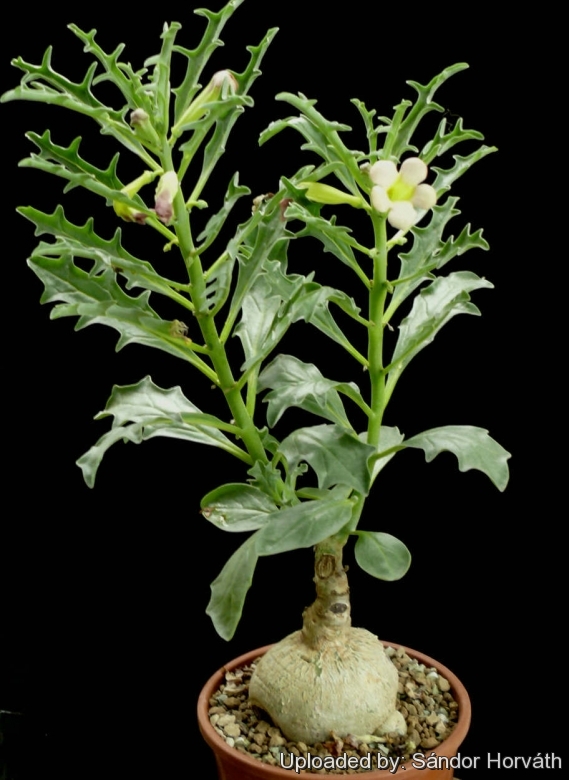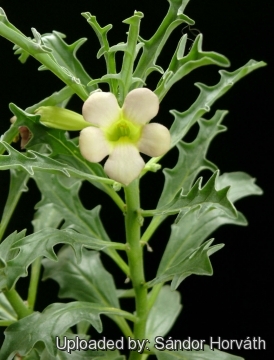




Your support is critical to our success.
- Encyclopedia of SUCCULENTS
- Encyclopedia Index
- Families
- Genera
- Species
- Pedaliaceae
- Pterodiscus
- Caudiciforms
Since 4 Aug 2013

Origin and Habitat: Pterodiscus luridusSN|32407]]SN|32407]] has a very restricted distribution area in the Eastern Cape (Kalahari Region Griqualand West) in the southern coast of South Africa.
Habitat and Ecology: Pterodiscus luridusSN|32407]]SN|32407]] grows in scattered groups around low rocks in low-lying areas where the soil is sandy, often together with populations of Crinum buphanoides, Crinum minimum and Crinum foetidum. Scadoxus multiflorusSN|32416]]SN|32416]] also is frequent in this area. The population trend is stable.
Synonyms:
- Pterodiscus luridus Hook.f.
ENGLISH: Lurid flowered Pterodiscus
Description: Pterodiscus luridusSN|28070]]SN|32407]] is a caudiciform plant similar in many parts to Pterodiscus aurantiacusSN|32407]]SN|28070]]. It has a stout tuberous stem base or caudex rising a few cm above the ground, and sending forth from its crown, on the approach of the wet season, a few herbaceous, succulent, leafy, flowering branches covered, like the leaves and flowers, with a powdery pruinose pubescence. The leaves are oblong, deeply scalloped, upper surface dark green, lower surface bluish. The trumpet-like flower are dirt yellowish with many red dots on the outside. The fruits is round and 4-winged. This member of the Pedaliaceae family was described by Joseph Dalton Hooker in 1869.
Derivation of specific name: 'luridus' (Latin), drab yellow, dirty brown, for the flower colour.
Stem-base (caudex): Thickish-fleshy, stout, about 30-40 cm tall, 3/4 of which is normally underground, upper part conical 6-7 cm in diameter at the widest part and 1.5-2 cm at the top, bark smooth, pale grey. The tuber is often raised in cultivation.
Annual stems: Shoots 15-20 cm long, stout, spreading, rather flexuous, like the leaves and flowers more or less mealy-glandular. The annual stems are deciduous, and generally die in winter when the plant is dormant.
Leaves: Rather numerous, oblong in outline, cuneate at the base, pinnatifid to or beyond the middle, 5-7.5 cm long, up to 2.5 cm broad, dark green above, whitish or glaucous beneath. Lobes linear or oblong from a triangular base, entire. Lower petioles up to 18 mm long with a small sessile depressed gland on each side.
Inflorescences: Flowers solitary axillary. Pedicels 4 mm long 2-glandular at the base, slender. Calyx 2-3 mm long, triangular-lanceolate, unequal, acute. Corolla slightly asymmetric. Corolla tube slightly curved vertically compressed gibbous, widened from above the base, slightly inflated at the middle, 25 mm long, 8 mm wide, pale green, throat transversely reniform. Limb dirty orange-yellow tinged with purple on the outside, almost 25 mm across. Lobes short 6 mm long, 8 mm broad retuse spreading pale dirty orange yellow or brown. Filaments bearded at the very base, otherwise glabrous. Ovule 1 in each cell.
Fruit: Orbicular, cordate at the base, subemarginate at the apex, 18-20 mm long, including the wings which are 8 mm broad towards the base.
Bibliography: Major references and further lectures
1) O. Stapf. “Flora Capensis”, Vol 4, 1904
2) Sir William Jackson Hooker “Curtis's Botanical Magazine”, Volume 95 Reeve Brothers, 1869
3) Foden, W. & Potter, L. 2005. “Pterodiscus luridus Hook.f.” National Assessment: Red List of South African Plants version 2015.1. Accessed on 2016/01/20
4) Clive Innes “Complete Handbook of Cacti and Succulents” Van Nostrand Reinhold Company, 01 December 1981
5) Urs Eggli, Leonard E. Newton “Etymological Dictionary of Succulent Plant Names” Springer Science & Business Media, 29 June 2013

Pterodiscus luridus Photo by: Sándor Horváth

Pterodiscus luridus Photo by: Frikkie Hall
Cultivation and Propagation: Pterodiscus luridusSN|32407]]SN|32407]] is a caudiciform plant that grows relatively easily and doesn't produce as many stems and leaves as other caudiciforms, making its management easier. The caudex generally underground in the wild is often raised in cultivation.
Growth rate: It grows well, though very slowly, but it possible to increase the speed of growth to some extent by providing adequate amount of water, warmth, and fertilizer during the active growing season, but it’s susceptible to rotting if too wet.
Potting medium: Since roots are quite succulent, use a slightly acidic cactus mix or add extra perlite, vulcanite or pumice to regular soil potting soil. A gritty, very free-draining compost is suitable, and clay pots help the plants to dry out between watering. It like pots with generous drain hole, re-pot every 2 years.
Frost tolerance: Due to its African origin keep warm in winter, the minimum safe average temperature is 5°C, although it can go lower for short periods. It can be grown outdoors in frost-free climates, need anyway to kept above 0°C and dry in winter.
Exposition: It likes a sunny position, but avoid direct blasting sun in summer. Keep the caudex in the shade.
Watering: It should be watered regularly when it begins to produce leaves in spring/summer and kept drier in Winter. Like most caudiciform it likes lots of water during warm and hot weather, and is accustomed to growing under other plants. Make sure after watering, that the soil is actually wet. Many potting soil mixes will have only the surface wet, with water running down the outside of the root ball, and most of the soil dry. Run your finger into the soil 15 minutes after watering to check. Too high or too low temperature will induce dormancy.
Traditional uses:An infusion made from the whole plant is given to cows to remove retained placenta after delivery.
Maintenance: Repot every two years.
Propagation: The mode of Propagation is by seed.
| Your Actions | |
|---|---|
| Back to Pterodiscus index | |
| Back to Pedaliaceae index | |
 |
Back to Succulents Encyclopedia index |
Privacy stantement - Terms and conditions - How to cite - About us - Feedback - Donate



